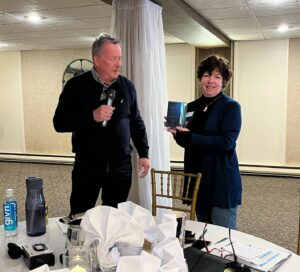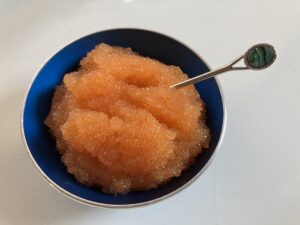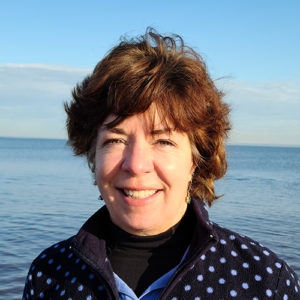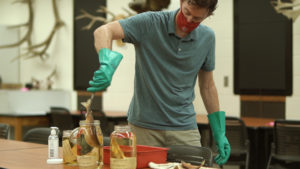Moen honored by Wisconsin’s commercial fishers
Last week, Sea Grant’s Sharon Moen was the recipient of an Appreciation Award from the Wisconsin Commercial Fishing Association to honor her work to secure the overseas market for whitefish and cisco roe in Sweden.
In 2021, Moen responded to Wisconsin commercial fisher and fish processor requests for help in addressing challenges to the export of Great Lakes lake whitefish and Lake Superior cisco roe to Sweden. Negative sustainability ratings developed by the World Wildlife Fund-European Union prompted ICA Sweden–the largest grocery market chain in the country–and other markets, to remove the roe from shelves.
Moen, food-fish outreach coordinator, intervened and due to that educational outreach spanning roughly two years, the rating was changed last fall so sales valued at $15 million annually can resume.

Sharon Moen accepts an award from the president of Wisconsin’s commercial fishing industry in honor of her work to restore a $15-million overseas market for Great Lakes fish products. Photo: Cindy Hudson, Michigan Sea Grant.
“I’m so pleased Wisconsin Sea Grant could facilitate the flow of evidence-based information in a way that helped the commercial fishing industry,” Moen said. “Sustainable fisheries management is an important topic and one our commercial fishers, fisheries managers and Sea Grant takes seriously.”
About Moen’s contribution, the association’s president Daniel Schwarz, said, “Moen’s commitment to this global project was extraordinary. No matter the size of the obstacle thrown her way, she managed to effectively tackle it and successfully conquer it. It is rare these days to see someone who truly cares to the point of no option for failure. Moen took the time to understand the issues at hand directly meeting with fishermen, processors/exporters around the upper Great Lakes in addition to reaching out to regulating government offices to collect updated correct information regarding the current status of the upper Great Lakes fishing industry.”
He continued, “Moen then effectively communicated all this information to Scandinavian regulatory agencies as well as consumers to build back the confidence in and credibility of the Great Lakes products. This enormous undertaking by one person took great leadership and communication skills, determination and passion.”
Schwarz is the owner of Dan’s Fish Inc., which is based in Sturgeon Bay. Wisconsin’s tribal and state-licensed commercial fishers primary catch lake whitefish, cisco and lake trout from Lake Superior. In Lake Michigan, state-licensed commercial fishers target lake whitefish and yellow perch. Burbot, rainbow smelt and chubs also make up part of Wisconsin’s Great Lakes commercial catch.
The post Moen honored by Wisconsin’s commercial fishers first appeared on Wisconsin Sea Grant.
News Releases | Wisconsin Sea Grant
News Releases | Wisconsin Sea Grant
https://www.seagrant.wisc.edu/news/moen-honored-by-wisconsins-commercial-fishers/



